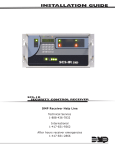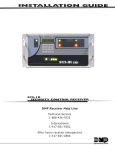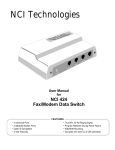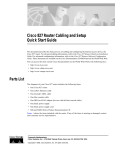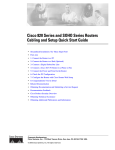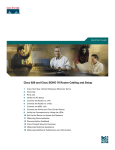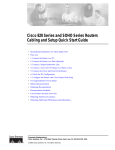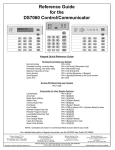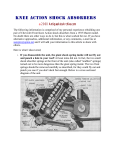Download DMP Electronics SCS-1R User`s guide
Transcript
SECURITY CONTROL RECEIVER MODEL SCS-1 INSTALLATION AND USER'S GUIDE Copyright © 1986 – 1994 Digital Monitoring Products, Incorporated Information furnished by DMP is believed to be accurate and reliable. This information is subject to change without notice. TABLE OF CONTENTS 4 5 6 Section Model SCS-208 Power Cord Description and Installation ......................................................... 3.8 Model SCS-203 Convenience Panel Description .................................................................................. 3.9 Installation ................................................................................... 3.9A Model SCS-PTR Printer and Cable Description .................................................................................. 3.10 Installation ................................................................................... 3.10A Printer Configuration ................................................................... 3.10B Model SCS-CRT Video Display , Keyboard, and Cable Description .................................................................................. 3.11 Installation ................................................................................... 3.11A CRT Configuration ....................................................................... 3.11B Special Keys ................................................................................ 3.11C System Block Diagram OPERATOR'S GUIDE Principle Terms For The Security Control ................................... 4.1 How To “Talk” To The Security Control ....................................... 4.2 Alarm Acknowledge ..................................................................... 4.3 Additional Signal Holding ............................................................ 4.4 Operator Signon .......................................................................... 4.5 Operator Signoff .......................................................................... 4.6 Set System Time/Day/Date ......................................................... 4.7 Network Definitions ..................................................................... 4.8 Operator Codes ........................................................................... 4.9 Configure System ........................................................................ 4.10 Redisplay Non-Restored Status .................................................. 4.11 PRINTOUT EXPLANATIONS General Description ......................................................................... 5.1 System Messages Description .................................................................................. 5.2 Operator Signon/Signoff .............................................................. 5.3 Time/Day/Date ............................................................................ 5.4 Operator Codes ........................................................................... 5.5 System Number ........................................................................... 5.6 Telephone Line Configuration ..................................................... 5.7 Network Definitions ..................................................................... 5.8 Command Processor Messages Description .................................................................................. 5.9 Alarm, Trouble and Restore ........................................................ 5.10 Ambush ....................................................................................... 5.11 Opening and Closing Reports ..................................................... 5.12 Bypass and Reset ....................................................................... 5.13 Add and Delete Codes ................................................................ 5.14 Schedule Changes ...................................................................... 5.15 Door Access ................................................................................ 5.16 Supervisory Messages ................................................................ 5.17 Explanations for Selected Supervisory Messages ...................... 5.18 Acknowledgment of Fire and Supervisory Alarms & Troubles .... 5.19 Message Destinations ................................................................. 5.20 ERROR MESSAGES AND PRINTER TROUBLESHOOTING Error Messages Description .................................................................................. 6.1 Access Denied! ........................................................................... 6.2 Changing Line Type Will Cause Network.. .................................. 6.3 *End of Job* ................................................................................ 6.4 Invalid Code! Try Again ............................................................... 6.5 Invalid Response! ........................................................................ 6.6 Invalid Selection! ......................................................................... 6.7 Operator Memory Full! ................................................................ 6.8 Operator Which is Signed On May Not Be Erased! .................... 6.9 Activity Log Error ......................................................................... 6.10 1 - SYSTEM OVERVIEW SYSTEM OVERVIEW 1.1 Description The SCS-1 Receiver system from DMP is comprised of a full featured digital/multiplex capable alarm receiver, a CRT display for viewing incoming reports, a local 80 character printer, and a detachable keyboard for acknowledging reports and configuring the SCS-1 system and its components. 1.2 Function The SCS-1 Receiver system provides central stations with computerized monitoring of DMP command processor panels. Features of the SCS-1 receiver include automatic logging of alarm, trouble, and supervisory account reports on a local printer with the date and time of their occurrence. 1.3 CRT Display The CRT display adds flexibility to the SCS-1 system by allowing the operator to view alarm reports before acknowledging them from the system keyboard. A typical account report includes: Account Number 12345 Loop Name FRONT DOOR, BACK DOOR Alarm Type Burglary, Fire, Panic Time and Date of occurrence All information is displayed on the CRT screen and logged on the local printer. Opening and Closing reports from monitored accounts provide the operator with: Account Number 12345 Area Numbers and Names - Area: 1 OFFICE Area: 2 STOCKROOM User Number of Individual - Disarmed by User #25 Time and Date of Occurrence 1.4 Printer Routine reports are logged on the printer without need of operator response while supervisory reports are logged on the printer and displayed on the CRT console for operator acknowledgment. 1.5 Additional Reports Other reports transmitted to the SCS-1 by DMP Command Processor panels include: • Addition and deletion of code numbers including user number of the person making the change • Bypass and reset of zones by number and name including user number of the person making the change • Schedule changes including user number of the person making the change • Trouble and Restoral report by zone name and number • Door access reports including user number and number of the door being accessed Section 5 of this guide provides a detailed explanation of the alarm and activity reports that can be logged on the SCS-1 printer or displayed on the CRT. 1.6 Line Capacity The SCS-1 Receiver accommodates up to five incoming phone lines. Each SCS-1 can be configured with both digital dialer and multiplex receiving lines. Multiplex lines have a capacity of 128 separate accounts. Digital Dialer lines have a capacity of 65,535 separate accounts. To select the communication type used on each incoming line, refer to Configure System in section 4.10. 1.7 24 Hour Recall Tests The automatic recall test from a digital dialer account must be tracked manually or with a listed automation system. The SCS-1 Receiver does not automatically indicate a delinquent recall test. Failure to receive a signal from a Digital Alarm Communicator Panel (DACT), over a 24 hour period shall be handled as a trouble signal. SCS-1 Install/User's Guide 2841 E. Industrial Drive Springfield, MO 65802-6310 800-641-4282 1 2 - INSTALLATION INSTALLATION CHECKLIST 2.1 Cover Plates Remove the front plastic cover by twisting the four knobs 90 degrees. Remove the two metal rear cover plates. The lower rear cover plate attaches to the three flat cables of the convenience panel. 2.2 Earth Ground Connect the ground lug on the rear side of the modem rack to earth ground. See Section 3.2. A ground lug is provided on the SCS-1 for this purpose. Use a minimum of 14 gauge wire and ground to a cold water pipe or a ground rod. Do not ground to electrical conduit or telephone company ground. 2.3 Location of Circuit Boards Confirm the circuit boards in the modem rack and in the multibus rack are installed in the proper locations. See Section 3.2. Connect the line card flat cables to the processor card ports. See Section 3.4A. 2.4 SCS-208 Power Cord Connect the SCS-208 Power Cord from J3 of the multibus power supply card to J3 of the transformer card. See Section 3.8. 2.5 Phone Lines Connect the RJ11X cables provided with each line card to the phone lines used for alarm receiving. See Section 3.4B. 2.6 AC Power Connect the wiring for 120 VAC to the transformer card mounted on the rear of the modem rack. See Section 3.7B. Do not apply AC power yet. For UL Listed operation, use a UL Listed uninterruptible power supply. The UPS system must have a secondary power source and provide alarm contacts to indicate when the UPS switches from primary power to secondary power. Below is a list of UL listed UPS systems that provide the correct alarm contacts. Best Power Technology Any Series M or Models F2KVA-B F3KVA-B F5KVA-B Clary Corp. Any Series A-52 Elgar Models La Marche Any Series A-52 Topaz Any Series 82000 Models 84462-01 84864-01 84126-01 84130-01 UPS253-3B UPS373-3B UPS503-3B Other UL listed UPS systems that provide alarm contacts to indicate loss of primary power can be used. SCS-1 Install/User's Guide 2841 E. Industrial Drive Springfield, MO 65802-6310 800-641-4282 2 2 - INSTALLATION 2.7 Front and Rear Covers Replace the front plastic cover and the two metal rear covers. The louvered rear cover mounts on top. 2.8 CRT Display Connect the CRT Display, Keyboard, and RS-232 cable. See Sections 3.11B and 11.5. Connect the CRT to AC power and turn on the CRT power switch. The CRT must be located adjacent to the SCS-201 Cabinet for UL Listed operation. 2.9 Printer Connect the printer RS-232 cable. See Section 3.10A. Install paper, connect the printer to AC power, and turn on the printer power switch. 2.10 Start up Apply 120 VAC to the transformer card. The 120 volts supplied to the receiver, the CRT display and the printer(s) must be from the same UPS circuit. 2.11 Configuration After powering up the system, set the correct time, configure the phone lines, and enter the operator codes. Refer to Section 4 in this manual for instructions on completing the above tasks. SCS-1 Install/User's Guide 2841 E. Industrial Drive Springfield, MO 65802-6310 800-641-4282 3 3 - HARDWARE DESCRIPTION MODEL SCS-1 SECURITY CONTROL RECEIVER 3.1 Description The DMP SCS-1 Receiver as shipped from the factory includes all of the necessary system components to provide two lines of receiving capability. This package can be expanded to a maximum of five incoming lines. The SCS-1 includes the following: Quantity 1 1 2 1 1 1 1 1 1 1 Model Number SCS-201 SCS-1062 SCS-100 SCS-110 SCS-120 SCS-130 SCS-208 SCS-203 SCS-PTR SCS-CRT Name System Enclosure Processor Card Line Card Modem Power Supply Card Multibus Power Supply Card Transformer Card Power Cord Convenience Panel Printer and Cable CRT Display, Keyboard and Cable A detailed installation and operational description for each component follows in this section. MODEL SCS-201 SYSTEM ENCLOSURE 3.2 Description The SCS-201 provides housing for the receiver processor, power supply, line cards, and associated cables. The enclosure measures 13" deep, 9.75" high and 20" wide. 3 Amp Fuse SCS-110 Modem Power Supply 115 Volt AC Input SCS-100 Line Cards SCS-120 Multibus Power Supply SCS-1062 Processor SCS-130 Transformer Card Modem Rack Front View Multibus Rack Ground Lug Rear View Fan 3.2A Modem Rack Contained in the top of the System Enclosure is a 5.25" modem rack. The rack holds the modem power supply card and up to five line cards. The transformer card for connecting the 120 VAC is mounted on the rear of the modem rack. 3.2B Multibus Rack Contained in the bottom of the System Enclosure is a 3.5" multibus rack with cooling fan. The multibus rack holds the processor card and the multibus power supply card. 3.2C Installation Connect the System Enclosure to earth ground before making any connections to the modules. Use a minimum 14 gauge wire for grounding. A crimp type spade connector is provided for connecting the ground wire to the ground lug on the modem rack. SCS-1 Install/User's Guide 2841 E. Industrial Drive Springfield, MO 65802-6310 800-641-4282 4 3 - HARDWARE DESCRIPTION 3.4A Card Installation Install the SCS-100 with the card puller up in any one of the five right hand positions of the modem rack. Connect the 10 position flat cable between the line card and the processor card. PIN 1 OF THE FLAT CABLE CONNECTOR MUST BE IN THE SAME POSITION ON BOTH THE LINE CARD AND THE PROCESSOR CARD. The line number of the line card is determined by the processor card port number. 3.4B Phone Line Installation Install the RJ11X cable provided with the line card between the RJ11X connector on the front of the line card to a customer supplied RJ11X jack. Use a standard 103J voice grade line. A slot is provided in the receiver back plate for the RJ11X cable to pass through. The SCS-100 is registered with the FCC, registration number CCK8GW-16197-AL-N; Ringer Equivalence 1.2. 3.4C Phone Line Monitor The incoming phone line voltage is monitored when the Line Card is configured for digital dialer operation. During a loss of phone line voltage, the red Phone Line Fail LED is lit and the alert sounds. The alert can be silenced by pressing the silence switch on the line card. The LED remains lit until the phone line is restored. 3.4D Configuration for MPX or DD The SCS-100 can be used for either digital dialer or multiplex communication. To change configuration, set the four jumpers labeled J1, J2, J3, and J4 to the appropriate position. For multiplex communication, set the jumper labeled J10 for either 2-wire or 4-wire operation. For 4-wire operation, the yellow and black wires of the RJ11X cable become the receive pair for multiplex. Always set Jumper J10 for 2-wire operation when using digital dialer communication. 3.4E Power Monitor LED The green LED labeled PWR is lit when the power supply on the line card is in a good condition. 3.4F Data Communication LEDs The six yellow LEDs indicate the condition of the line card during the various stages of communication. A description of each LED is listed below: TD Transmit Data On when the line card is transmitting to a panel. RD Receive Data On when the line card is receiving data from a panel. CD Carrier Detect On when the carrier tone from the panel is detected on the phone line. OL On Line On when a line card configured for digital dialer has answered the phone line. Not used for MPX. RG Ring Detect On when ringing voltage is detected on phone line. Not used for MPX. DT Data Terminal Ready On when the line card is ready to receive. SCS-1 Install/User's Guide 2841 E. Industrial Drive Springfield, MO 65802-6310 800-641-4282 6 3 - HARDWARE DESCRIPTION MODEL SCS-120 MULTIBUS POWER SUPPLY CARD 3.6 Description The SCS-120 provides power to the processor card through the multibus backplane. The SCS-120 also monitors the condition of the processor card, the voltage output of the modem power supply card, and its own internal voltages. SCS-1062 PROCESSOR +5 +12 OK MODEM POWER TRBL OK TRBL OK TRBL TRBL POWER ALERT SILENCE OK FAIL RESTART J3 -12 3.6A Installation Always disconnect power to the receiver when installing or removing the SCS-120. Install the board with the component side up in the upper position of the multibus rack. Connect the SCS-208 Power Cable to J3 on the front right side of the card. Connect the other end of the power cable to the transformer card on the back of the modem rack. The power cable can be used in either direction. 3.6B Processor Monitor The SCS-120 monitors the processor of the Model SCS-1062 through the multibus backplane. The green OK LED lights when the processor is operating. If the processor stops operating, the red FAIL LED lights and the failure buzzer on the SCS-120 sounds. Press the processor restart button to restart the system, silence the buzzer, and turn off the red LED. The restart button restarts the system and resets the time of day. All other system configuration information is not changed. 3.6C Power Monitor LEDs The SCS-120 monitors three different system voltages, +5, +12, -12 and the modem power supply. Four LEDs located to the right of the power trouble silence switch display any voltage failure. A green OK LED lights when the voltages are in good condition. The green PWR LED for the modem power supply is located on the modem power supply card. The red TRBL LED lights and the trouble alert on the SCS-120 sounds when there is a problem with a voltage level. Press the power trouble silence switch to silence the alert. The red TRBL LED remains lit until the power problem is corrected. The modem power LED, the trouble alert on the SCS-120, and the power trouble LED on the modem power supply operate together. SCS-1 Install/User's Guide 2841 E. Industrial Drive Springfield, MO 65802-6310 800-641-4282 8 3 - HARDWARE DESCRIPTION MODEL SCS-203 CONVENIENCE PANEL 3.9 Description The SCS-203 provides cabling for three RS-232 ports. The three ports are for the CRT display, host output, and activity log printer. To CRT To SCS-110 To Port 7 To Host Computer To Port 8 To Port 6 To Activity Log Printer 3.9A Installation Install the three 10 position flat cable connectors to ports 6, 7 and 8 of the processor card. Install the metal plate with the three 25 position RS-232 connectors on the receiver backplate using the two 6-32 x 1/4" screws provided. Connect the CRT display, printers and/or host computer to the RS-232 connectors. MODEL SCS-PTR PRINTER AND CABLE 3.10 Description The SCS-PTR is an 80 column printer with a 10' RS-232 cable. The printer can be connected to the all events output connector or the alarm only output connector. See Section 3.9. The SCS-1 Receiver is shipped with one printer. 3.10AInstallation The printer as shipped by DMP has all option switches preset. Install the RS-232 cable between the printer serial interface port and the receiver convenience panel connector. Remove any dummy plugs from the printer output connector. If a printer is not being installed, the dummy plug shorting pins 4 and 5 should remain on the connector. THE END OF THE CABLE MARKED PRINTER MUST BE INSTALLED INTO THE PRINTER. 3.10BPrinter Configuration Set the printer option switches on the Okidata ML 184T according to the tables below: Upper Serial Board Lower Control Board Switch Bank 1 Switch Bank 2 Switch Bank 1 1 OFF EVEN PARITY 1 ON 1 OFF 2 ON WITHOUT PARITY 2 ON 1200 BAUD 2 OFF ASCII 3 ON 8 BITS 3 OFF 3 OFF 4 ON READY/BUSY 4 OFF DSR 4 OFF 5 ON CIRCUIT/MONITOR 5 ON 32 BYTES BUFFER 5 ON 6 ON PRINT MODE 6 ON 200ms BUSY SIGNAL 6 ON AUTO LINE FEED 7 OFF 7 OFF DTR 7 ON 8 BITS 8 ON 8 OFF NOT USED 8 OFF ENABLE FRONT PANEL SCS-1 Install/User's Guide 2841 E. Industrial Drive Springfield, MO 65802-6310 800-641-4282 10 3 - HARDWARE DESCRIPTION 120 VAC INPUT UPS BROWNOUT INPUT J1 MODEL SCS-130 J2 TRANSFORMER CARD COOLING FAN MODEL SCS-110 MODEM RACK SUPPLY CARD J3 MODEL SCS-208 POWER CABLE MODEM RACK BACKPLANE J3 10 CONDUCTOR FLAT CABLE MODEL SCS-120 MULTIBUS POWER SUPPLY CARD RJ11X CABLE MODEL SCS-100 LINE CARD LINE 1 MODEL SCS-100 LINE CARD LINE 2 MULTIBUS BACKPLANE PORT 1 PORT 2 MODEL SCS-1062 PROCESSOR CARD PORT 3 MODEL SCS-100 LINE CARD LINE 3 MODEL SCS-100 LINE CARD LINE 4 PORT 4 PORT 5 PORT 6 7 8 MODEL SCS-100 LINE CARD MODEL SCS-203 CONVENIENCE PANEL MODEL SCS-PTR PRINTER AND CABLE MODEL SCS-CRT CRT DISPLAY AND KEYBOARD LINE 5 HOST COMPUTER SCS-1 Install/User's Guide 2841 E. Industrial Drive Springfield, MO 65802-6310 800-641-4282 12 4 - OPERATOR'S GUIDE 4.1 Principle For The Security Control This is an alphabetical list of terms used in the SCS-1 Receiver system operating instructions. An operator can refer to these explanations for additional information. \ (Back slash) A key located on the Security Control keyboard used to acknowledge messages as they're displayed on the CRT. Alphanumeric A set of characters consisting of either the letters A through Z, the digits 0 through 9, special symbols, or a combination of all of these. For example: the set of characters "AB76#2", is alphanumeric. Character One of a set of symbols that can be arranged in groups to express information. This includes the digits 0 through 9, the letters A through Z, punctuation marks, and other special symbols. Command Processor Programs The data programmed into a DMP command processor panel at the time of installation. A typical program includes: communication information, system options, area information, loop information, and the number and type of Security Command keypads in the system. This should not be confused with System Programs that are software routines used by the SCS-1 to execute functions described in the Operations Manual. CRT A computer monitor used to display information and a computer keyboard that allows you to enter information. Cursor A flashing underline symbol on the CRT display for use when entering or changing information. Default Value A value assigned to a field by the SCS-1. The receiver assigns the value to that field allowing the operator to accept its entry and respond to the next field. Del (Delete) A key located on the SCS-1 keyboard that clears the information currently in the cursor location. The cursor then moves to the next field. The use of this key varies between programs. Entry Information typed into the SCS-1 through the keyboard attached to the CRT. This information is entered into the system when the Return key is pressed. Field A single item of information on a CRT screen. For example: a field within the System Configuration program would be the company name. Another field in this selection would be the type specification for line 2. Menu A CRT display that lists the program selections available to the operator. SCS-1 Install/User's Guide 2841 E. Industrial Drive Springfield, MO 65802-6310 800-641-4282 13 4 - OPERATOR'S GUIDE 4.2 Numeric Description of numerical information. For example: the set of characters 1 2 3 4 5 is numeric. Down Cursor A key located on the SCS-1 keyboard that moves the cursor back to the previous field allowing you to change a previous entry. Esc A key located on the SCS-1 keyboard that terminates the current selection and returns you to the System Menu. User Number The sequential number assigned to each user code number by the panel during its programming. This is the number transmitted to the SCS-1 Receiver. The actual code number is never transmitted. How to Operate the Security Control Entering information into the SCS-1 is simple. The CRT first displays a message, or prompt, indicating that information needs to be entered in a field. After you type in the information, press the return key to allow the system to start processing your entry and move the cursor to the next field. If you make a mistake while typing information, use the BACKSPACE key to move the cursor under the character you want to change and then type in the correct information. To change an entire word or series of characters, move the cursor under the first letter of the word or first character and type in the correct information. There are three special keys to help you enter information: Down Cursor, Esc, and Del. See Section 3.11C Special Keys. The Down Cursor key backs up the cursor to the previous FIELD allowing you to change information already entered. The Esc key allows you to terminate the current selection and return to the System Menu. The Del key allows you to delete all data contained in the FIELD designated by the cursor. The Del key may not work in some fields; it's correct use is given at the beginning of each program description. Detailed instructions on how to operate the system programs are contained on the following pages. SCS-1 Install/User's Guide 2841 E. Industrial Drive Springfield, MO 65802-6310 800-641-4282 14 4 - OPERATOR'S GUIDE 4.3 Alarm Acknowledge Any time an emergency message is received by the SCS-1 Receiver, the keyboard locks, an alert sounds and a message is displayed similar to the example shown below. The alert continues to sound until the \ (Back slash) key is pressed on the keyboard acknowledging the alarm. The keyboard then returns to normal operation. After an emergency message has been acknowledged it's written over by the next emergency message. Refer to Section 5, PRINTOUT EXPLANATIONS, for a description of the various messages that can be displayed for acknowledgment. 1-12345 LOOP: 10 FRONT DOOR-BURGLARY ALARM 10:56 a.m. ENTER SELECTION: SCS-1 Install/User's Guide 2841 E. Industrial Drive Springfield, MO 65802-6310 800-641-4282 15 4 - OPERATOR'S GUIDE 4.4 Additional Signal Holding When any emergency message is being displayed for acknowledgment and a second emergency message is received, Additional Signal Holding is displayed on line 2 of the CRT display. This message remains displayed until only one message remains to be acknowledged. When more than one message is holding in the receiver memory, the messages are prioritized for display in the following order: 1) 2) 3) 4) 5) Fire alarms Panic and Burglary alarms Supervisory, Emergency and Auxiliary alarms Fire and Burglary troubles and restorals Other messages 1-12345 LOOP: 10 FRONT DOOR- BURGLARY ALARM 10:56 a.m. Additional Signal Holding ENTER SELECTION: SCS-1 Install/User's Guide 2841 E. Industrial Drive Springfield, MO 65802-6310 800-641-4282 16 4 - OPERATOR'S GUIDE 4.5 On - Operator Signon This selection allows you to access the system programs. The programs available on the SCS-1 are: Set System Time/Day/Date, Network Definitions, Operator Codes, and Configure System. To sign on, type ON and press RETURN. The operator’s name is logged on the ACTIVITY LOG printer. The following page shows the sequence for signing on. ENTER SELECTION: ON OPERATOR SIGNON SCS-1 Install/User's Guide 2841 E. Industrial Drive Springfield, MO 65802-6310 800-641-4282 17 4 - OPERATOR'S GUIDE OPERATOR SIGNON - ON REMEMBER: -Use RETURN to enter a field and to move to the next field. -The next field does not appear until the previous field is entered. FIELD NAME ENTER OPERATOR CODE: OPERATOR RESPONSE Enter your operator code and press RETURN. The system menu is then displayed. If this is the first time the system has been used, type NEW to gain access to the system menu. The operator code is not displayed as it is entered. ENTER OPERATOR CODE: SCS-1 Install/User's Guide 2841 E. Industrial Drive Springfield, MO 65802-6310 800-641-4282 18 4 - OPERATOR'S GUIDE 4.6 Off - Operator Signoff This selection allows you to exit the system programs. This selection must be made before a new operator can sign on. The operator’s name is logged on the ACTIVITY LOG printer after signing off. ENTER SELECTION: OFF TDD NET OPC CON RED OPERATOR SIGNOFF SET SYSTEM TIME/DAY/DATE NETWORK DEFINITIONS OPERATOR CODES CONFIGURE SYSTEM REDISPLAY NON-RESTORED STATUS SCS-1 Install/User's Guide 2841 E. Industrial Drive Springfield, MO 65802-6310 800-641-4282 19 4 - OPERATOR'S GUIDE 4.7 TDD - Set System Time/Day/Date This selection allows you to set the correct time, day, and date on the SCS-1. All changes made in this selection are logged on the ACTIVITY LOG printer. ENTER SELECTION: OFF TDD NET OPC CON RED OPERATOR SIGNOFF SET SYSTEM TIME/DAY/DATE NETWORK DEFINITIONS OPERATOR CODES CONFIGURE SYSTEM REDISPLAY NON-RESTORED STATUS SCS-1 Install/User's Guide 2841 E. Industrial Drive Springfield, MO 65802-6310 800-641-4282 20 4 - OPERATOR'S GUIDE SET SYSTEM TIME/DAY/DATE - TDD REMEMBER: -Use the Down Cursor to go back one field. -Use Esc to exit the current program. -Del has no function in this selection. -Use Return to enter a field and step to the next field. -The next field does not appear until the previous field is entered. FIELD NAME OPERATOR RESPONSE ENTER TIME: Enter the time. For example: 2:30 pm DAY: Enter the day of the week. DATE: Enter the month, date, and year. (MM/DD/YY) After this entry, the system menu returns automatically. ENTER TIME: DAY: DATE: SCS-1 Install/User's Guide 2841 E. Industrial Drive Springfield, MO 65802-6310 800-641-4282 21 4 - OPERATOR'S GUIDE 4.8 NET - Network Definitions This selection allows you to assign Multiplex command processor numbers to the SCS-1. Telephone lines to which Multiplex account numbers are assigned must have the correct type specification in the Configure System program. A Multiplex communication system polls up to 128 accounts on each telephone line. Assigning each account number in service to a line on the SCS-1 ensures only valid accounts are polled. This speeds up communication cycles. Since digital dialers initiate the communication to the receiver and are not polled, it is not necessary to assign digital dialer account numbers to a line. Telephone lines specified as DD will not accept account number assignments. The entire line specification is logged on the ACTIVITY LOG printer when any item in the configuration is changed. ENTER SELECTION: OFF TDD NET OPC CON RED OPERATOR SIGNOFF SET SYSTEM TIME/DAY/DATE NETWORK DEFINITIONS OPERATOR CODES CONFIGURE SYSTEM REDISPLAY NON-RESTORED STATUS SCS-1 Install/User's Guide 2841 E. Industrial Drive Springfield, MO 65802-6310 800-641-4282 22 4 - OPERATOR'S GUIDE NETWORK DEFINITIONS - NET REMEMBER: PAGE 1 -Use the Down Cursor to go back one field. -Use Esc to exit the current program. -Use Return to enter a field and step to the next field. -The next field does not appear until the previous field is entered. -Del has no function in this selection. FIELD NAME LINE NUMBER: OPERATOR RESPONSE After making the NET selection, you'll be asked for the line number to which account numbers will be assigned. Enter the correct line number. If the line number entered has a type specification of MPX, continue on PAGE 2 of this section. LINE NUMBER: SCS-1 Install/User's Guide 2841 E. Industrial Drive Springfield, MO 65802-6310 800-641-4282 23 4 - OPERATOR'S GUIDE NETWORK DEFINITIONS - NET (Multiplex Line) FIELD NAME DO YOU WISH TO ADD-DELETE OR DISPLAY? (A,D): PAGE 2 OPERATOR RESPONSE If A is entered, you'll be asked for a panel number. Refer to PAGE 3 of this section for the correct response. If D is entered, all Multiplex panel numbers assigned to this line will be displayed on the CRT screen. DO YOU WISH TO ADD-DELETE OR DISPLAY? (A,D): LINE NUMBER: ACCOUNT NUMBER RANGE: NEXT PANEL NUMBER AVAILABLE: TOTAL PANEL NUMBERS IN USE: SCS-1 Install/User's Guide 2841 E. Industrial Drive Springfield, MO 65802-6310 800-641-4282 24 4 - OPERATOR'S GUIDE NETWORK DEFINITIONS - NET (Multiplex Line) FIELD NAME ENTER PANEL NUMBER: PANEL NUMBER NOT ASSIGNED. DO YOU WISH TO ADD IT? PAGE 3 OPERATOR RESPONSE If the panel number entered is not previously assigned, the following field is displayed: If the response is Y, the panel number is assigned and the information fields are updated. The cursor returns for another panel number. An N response returns the cursor for another panel number. If the panel number entered is already assigned, the following field is displayed: PANEL NUMBER ALREADY ASSIGNED. DO YOU WISH TO DELETE IT? If the response is Y, the panel number is deleted and the information fields are updated. The cursor returns for another number. An N response returns the cursor for another panel number. ENTER PANEL NUMBER: LINE NUMBER: ACCOUNT NUMBER RANGE: NEXT PANEL NUMBER AVAILABLE: TOTAL PANEL NUMBERS IN USE: SCS-1 Install/User's Guide 2841 E. Industrial Drive Springfield, MO 65802-6310 800-641-4282 25 4 - OPERATOR'S GUIDE NETWORK DEFINITIONS - NET (DSAS Line) FIELD NAME DO YOU WISH TO ADD-DELETE OR DISPLAY? (A,D): PAGE 4 OPERATOR RESPONSE If A is entered, you'll be asked for the port number you wish to assign panel numbers to. Refer to PAGE 5 of this selection for the correct response. If D is entered, all port and panel assignments are displayed on the CRT screen. DO YOU WISH TO ADD-DELETE OR DISPLAY? (A,D): LINE NUMBER: ACCOUNT NUMBER RANGE: NEXT PANEL NUMBER AVAILABLE: NEXT PORT AVAILABLE: TOTAL PANEL NUMBERS IN USE: TOTAL PORTS IN USE: SCS-1 Install/User's Guide 2841 E. Industrial Drive Springfield, MO 65802-6310 800-641-4282 26 4 - OPERATOR'S GUIDE NETWORK DEFINITIONS - NET (DSAS Line) FIELD NAME ENTER PORT NUMBER: PAGE 5 OPERATOR RESPONSE Enter the port number you're assigning a panel number to. When entered, the port number is displayed on the CRT screen with any panel numbers that are assigned to it. ENTER PORT NUMBER: LINE NUMBER: ACCOUNT NUMBER RANGE: NEXT PANEL NUMBER AVAILABLE: NEXT PORT AVAILABLE: TOTAL PANEL NUMBERS IN USE: TOTAL PORTS IN USE: SCS-1 Install/User's Guide 2841 E. Industrial Drive Springfield, MO 65802-6310 800-641-4282 27 4 - OPERATOR'S GUIDE NETWORK DEFINITIONS - NET (DSAS Line) PAGE 6 FIELD NAME ENTER PANEL NUMBER: NOT ASSIGNED. DO YOU WISH TO ADD TO PORT XX? OPERATOR RESPONSE When a panel number is entered, the SCS-1 checks to see if it is already assigned to a port. If it's not assigned, the following field is displayed: If the response is Y, the panel number is assigned to the port on the CRT display and all information fields are updated. The cursor returns for another port number. A N response returns for another port number. If a panel number entered is already assigned to a port the following field is displayed: ALREADY ASSIGNED TO PORT XX. DO YOU WISH TO DELETE? If the response is Y, the panel number is deleted from the port it's assigned to and all information fields are updated. The cursor returns for another port number. An N response returns for another port number. ENTER PANEL NUMBER: LINE NUMBER: ACCOUNT NUMBER RANGE: NEXT PANEL NUMBER AVAILABLE: NEXT PORT AVAILABLE: TOTAL PANEL NUMBERS IN USE: TOTAL PORTS IN USE: PORT XX: YY ZZ SCS-1 Install/User's Guide 2841 E. Industrial Drive Springfield, MO 65802-6310 800-641-4282 28 4 - OPERATOR'S GUIDE 4.9 OPC - Operator Codes This selection allows you to add and delete operator codes. This entry consists of three parts; the operator name or initials, code, and access level. The table below shows the different functions that are available to the different code levels: Table A No Code Level 1 to 4 X X Signon Redisplay Non-Restored Status Acknowledge Alarms Set System Time Day and Date Level 5 to 7 Level 8 Level 9 X X X X X X X X X X X X X X X X Network Definitions Configure System X Operator Codes X Any addition or deletion of operator names or changes in access level are logged on the ACTIVITY LOG. ENTER SELECTION: OFF TDD NET OPC CON RED OPERATOR SIGNOFF SET SYSTEM TIME/DAY/DATE NETWORK DEFINITIONS OPERATOR CODES CONFIGURE SYSTEM REDISPLAY NON-RESTORED STATUS SCS-1 Install/User's Guide 2841 E. Industrial Drive Springfield, MO 65802-6310 800-641-4282 29 4 - OPERATOR'S GUIDE OPERATOR CODES - OPC REMEMBER: -Use the Down Cursor to go back one field. -Use Esc to exit the current program. -Use Del to delete entire lines. -Use Return to enter a field and step to the next field. -The next field does not appear until the previous field is entered. FIELD NAME OPERATOR RESPONSE SYSTEM NUMBER: The correct system number is displayed for reference only and cannot be changed from this program. OPERATOR: Enter the operator name or initials, maximum of 4 alphanumeric characters. If the name does not exist, it is added to the list. If it does exist it is highlighted and the corresponding code or level can be changed. Press Del to delete the operator name and corresponding code and level. CODE: Enter the operator code, maximum of 8 alphanumeric characters. LEVEL: Enter the operator level 1 to 4, 5 to 7, 8, or 9. After this entry, the cursor returns for the next operator name. Press Esc for return to the system menu. NOTE: If an operator name is entered without a code or level, the system automatically enters a code of ******** and a level of 1. SYSTEM NUMBER: OPERATOR: OPERATOR CODE: CODE LEVEL: LEVEL SCS-1 Install/User's Guide 2841 E. Industrial Drive Springfield, MO 65802-6310 800-641-4282 30 4 - OPERATOR'S GUIDE 4.10 CON - Configure System This selection is made to assign the company name and system number as well as the communication type for each incoming telephone line on the SCS-1 Receiver. ENTER SELECTION: OFF TDD NET OPC CON RED OPERATOR SIGNOFF SET SYSTEM TIME/DAY/DATE NETWORK DEFINITIONS OPERATOR CODES CONFIGURE SYSTEM REDISPLAY NON-RESTORED STATUS SCS-1 Install/User's Guide 2841 E. Industrial Drive Springfield, MO 65802-6310 800-641-4282 31 4 - OPERATOR'S GUIDE CONFIGURE SYSTEM - CON REMEMBER: PAGE 1 -Use the Down Cursor to go back one field. -Use Esc to exit the current program. -Use Del to clear phone number, bill number and comment fields. -Use Return to enter a field and step to the next field. -The next field does not appear until the previous field is entered. FIELD NAME OPERATOR RESPONSE COMPANY NAME: Enter your company name up to 40 characters. SYSTEM NUMBER: Enter the number of this system. NOTE: This is not the operational level of the system but an identifier to distinguish between multiple Systems. KEY: Enter your company receiver key. Note: this is an eight character alphanumeric field. This key is requested by command processor control panels in the field when remote programming is being done. Once entered this key will not display and it should never be changed. CO NAME: SYSTEM NO: KEY: COMPANY NAME SYSTEM NUMBER SCS-1 Install/User's Guide 2841 E. Industrial Drive Springfield, MO 65802-6310 800-641-4282 32 4 - OPERATOR'S GUIDE CONFIGURE SYSTEM - CON PAGE 2 FIELD NAME OPERATOR RESPONSE LINE NO. is to be specified. Enter the line number for which the communication method TYPE: Enter the communication method. MPX = Multiplex DD = DMP Digital Dialer ASYN = Asynchronous communication NONE = Clear all information for the line. PHONE NUMBER: Enter phone number of digital dialer line. Maximum 13 characters. BILL NUMBER: Enter the bill number for this phone line. Maximum 10 characters. LINE NO: COMPANY NAME SYSTEM NUMBER LINE TYPE PHONE NUMBER BILL NUMBER COMMENT ERR% CALLS 1 .00 0 2 .00 0 3 .00 0 4 .00 0 5 .00 0 HOST MESSAGES: 0 SCS-1 Install/User's Guide 2841 E. Industrial Drive Springfield, MO 65802-6310 800-641-4282 33 4 - OPERATOR'S GUIDE CONFIGURE SYSTEM - CON FIELD NAME PAGE 3 OPERATOR RESPONSE COMMENT: After the bill number is entered, you can enter a comment for this line, maximum 15 characters. After this entry, the cursor returns for the next line number. Press Esc to return to the system menu. ERR%: This is a display only field. It displays the percentage of communication troubles by line since midnight. CALLS: This is a display only field. It displays the total number of calls by line since midnight. If MPX, the number of information frames is displayed. HOST MESSAGES: This is a display only field. It displays the total number of reports sent to the host computer since midnight. TYPE: PHONE NUMBER BILL NUMBER COMMENT: COMPANY NAME SYSTEM NUMBER LINE TYPE PHONE NUMBER BILL NUMBER COMMENT ERR% CALLS 1 .00 0 2 .00 0 3 .00 0 4 .00 0 5 .00 0 HOST MESSAGES: 0 SCS-1 Install/User's Guide 2841 E. Industrial Drive Springfield, MO 65802-6310 800-641-4282 34 4 - OPERATOR'S GUIDE 4.11 RED - Redisplay Non-restored Status This selection is made to display fire and supervisory type loops that have not restored from an alarm or trouble condition. The loops are listed in order by account number followed by loop number. When a restoral is received for a loop, it is automatically removed from the list. ENTER SELECTION: OFF TDD NET OPC CON RED OPERATOR SIGNOFF SET SYSTEM TIME/DAY/DATE NETWORK DEFINITIONS OPERATOR CODES CONFIGURE SYSTEM REDISPLAY NON-RESTORED STATUS SCS-1 Install/User's Guide 2841 E. Industrial Drive Springfield, MO 65802-6310 800-641-4282 35 4 - OPERATOR'S GUIDE REDISPLAY NON-RESTORED STATUS - RED REMEMBER: ACCOUNT -Use Return to display the next page. -Use Esc to exit the current program. -The information displayed on the screen is current as of the moment Return is pressed. It is not a “real time” display. To update the screen, press Return again. LP# LOOP NAME 1-12345 48 1-40345 6 1-40376 16 TYPE STAT ACCOUNT LP# LOOP NAME TYPE STAT SMOKE DET. Fire TRBL WATER MON. Supv ALRM HEAT DET. Fire ALRM Press ENTER for next page, Press ESC to go back to the menu. SCS-1 Install/User's Guide 2841 E. Industrial Drive Springfield, MO 65802-6310 800-641-4282 36 5 - PRINTOUT EXPLANATIONS 5.1 General Description The SCS-1 prints out two general types of messages: changes in the system information and reports received from DMP Command Processor panels. The message line for system changes is bracketed by double asterisks with the time of occurrence printed at the far right. Reports from panels always list the account number first followed by the message and the time of occurrence. The printout below is a typical page from the ACTIVITY LOG printer. The sequential numbers to the left are for reference and do not appear on the printout. The following pages describe the various messages that are listed by the SCS-1. ATLAS SECURITY SERVICE, INCORPORATED Wednesday 3/1/93 * * ACTIVITY LOG * * Page number: 2 ** * * RICK SIGNED ON * * * * 7:58 a.m. * * OPERATOR: PAT LEVEL: 8 ADDED TO OPERATOR CODES. * * 7:59 a.m. * * OPERATOR: DAVE LEVEL: 9 CHANGED TO LEVEL: 5. * * 7:59 a.m. * * SECURITY CONTROL SYSTEM NUMBER CHANGED TO: 1. * * 8:01 a.m. * * LINE: 3 CONFIGURED AS: DD PHONE NUMBER: (214) 555-1212 * * 8:02 a.m. BILL NUMBER: 2141175000 DIGITAL DIALER * * MULTIPLEX PANEL NUMBER: 108 ADDED TO LINE: 1 * * 8:04 a.m. ** * * RICK SIGNED OFF * * * * 8:07 a.m. 1-10001 Loop: 8 FRONT DOOR - BURGLARY ALARM 8:18 a.m. 1-10000 Loop: 2 BACK DOOR - BURGLARY TROUBLE 8:23 a.m. 1-10000 Loop: 2 BACK DOOR - BURGLARY RESTORE 8:24 a.m. 1-10000 * * AMBUSH * * 8:27 a.m. 1-10058 Area: 1 OFFICE - DISARMED User #07 8:31 a.m. 2 PLANT 3 SHIPPING 1-10045 Loop: 10 FRONT DOOR - BYPASSED User #15 8:33 a.m. 1-10072 User #09 added to panel User #02 8:33 a.m. 1-10117 Permanent schedule for Tuesday Area: 1 8:35 a.m. Open: 8:00 a.m. Close: 5:30 p.m. User #05 1-12345 Door Access at Door Number 05 User #21 8:36 a.m. 1-10045 WARNING: Panel ground fault indication. 8:38 a.m. 1-10187 Loop: 37 SMOKE DET. - * * ACK * * ALARM 8:40 a.m. SCS-1 Install/User's Guide 2841 E. Industrial Drive Springfield, MO 65802-6310 800-641-4282 37 5 - PRINTOUT EXPLANATIONS 5.2 System Messages System messages are provided on the ACTIVITY LOG printer to provide a permanent record of changes made to the system information. The operator making the change is determined by referring to the last sign on. A detailed explanation of each message follows: 5.3 Operator Sign on/Sign off This message is printed after an operator enters their code number to access the system menu. The name of the operator and the sign on time are printed. The code number of the operator is not printed. An example of this message is shown on line 3 of the sample printout. The same process is followed when the operator signs off. A sign off example is shown on line 10 of the sample printout. 5.4 Time/Day/Date When the time, day, or date is changed, the old and the new value are printed. An example of a date change is shown below. * * DATE CHANGED FROM: 1/1/82 TO: 9/1/82 * * Time and day changes follow the same format. 5.5 Operator Codes When a new operator is added to the system, the operator name and level are printed. An example is shown on line 4 of the sample printout. Any time a current operator is deleted from the system a similar message is printed. When only the operator level is changed, the old level and the new level are printed. An example is shown on line 5 of the sample printout. 5.6 System Number When the system number is changed, the new system number is logged. This is shown on line 6 of the sample printout. 5.7 Telephone Line Configuration Each time a change is made to any part of a line configuration, all parts of that configuration are printed. This message is a 2-line format shown on lines 7 and 8 of the sample printout. 5.8 Network Definitions Adding or deleting a Multiplex account from a Network Definition prints the panel number and line on the ACTIVITY LOG printer. An example is shown on line 9 of the sample printout. 5.9 Command Processor Reports Reports from Command Processor panels are sent to the SCS-1 advising of various changes in the panel status in the field. The reports can be logged on the printer and/or displayed on the CRT. The proper logging of each report is listed in Section 5.20. 5.10 Alarm, Trouble, and Restore These reports are formatted the same. Alarm and Trouble messages are logged on both printers and displayed on the CRT for acknowledgment. Fire and Supervisory restorals are displayed on the CRT for acknowledgment and logged on the ACTIVITY LOG while other restore messages are logged on the ACTIVITY LOG only. An example of each report is shown on lines 11 to 13 of the sample printout. SCS-1 Install/User's Guide 2841 E. Industrial Drive Springfield, MO 65802-6310 800-641-4282 38 5 - PRINTOUT EXPLANATIONS 5.11 Ambush The Ambush report is logged on both printers and displayed on the CRT for acknowledgment. An example of an Ambush report is shown on line 14 of the sample printout. 5.12 Opening and Closing Reports Openings and Closings list the areas being armed or disarmed and the user number making the change. These reports can be from 1 to 8 consecutive lines and are logged on the ACTIVITY LOG only. An example of this report is shown on lines 15 to 17 of the sample printout. 5.13 Bypass and Reset This report is printed in a one line format listing the zone number, zone name, and user number making the change. The report is logged on the ACTIVITY LOG only. An example of this message is shown on line 18 of the sample printout. 5.14 Add and Delete Codes This report lists the user number added or deleted along with the user number of the individual making the change. The report is logged on the ACTIVITY LOG only. An example is shown on line 19 of the sample printout. 5.15 Schedule Changes This is printed in a 2-line format listing the type of schedule (permanent or temporary), day of the week, opening and closing time, and the user number making the change. This report is printed on the ACTIVITY LOG only. An example is shown on lines 20 and 21 of the sample printout. 5.16 Door Access This report lists the user number accessing the door strike relay and the door which is being accessed. The door number matches the keypad address being operated by the user. An example is shown on line 22 of the sample printout. SCS-1 Install/User's Guide 2841 E. Industrial Drive Springfield, MO 65802-6310 800-641-4282 39 5 - PRINTOUT EXPLANATIONS 5.17 Supervisory Messages All supervisory reports follow the same format. The account number, the report, and the time of occurrence. An example is shown on the sample printout. The various supervisory reports are listed below: WARNING: A.C. power failure A.C. power restored WARNING: Low standby battery Standby battery restored WARNING: Auxiliary fuse trouble Auxiliary fuse restored WARNING: Bell fuse trouble Bell fuse restored WARNING: Panel ground fault Panel ground restored WARNING: Bell circuit trouble Bell circuit restored WARNING: Panel tamper Panel tamper restored WARNING: Low communication line level Communication line level restored WARNING: Panel backup communication fail Backup communication line restored WARNING: New panel on line WARNING: Non-alarm message overflow WARNING: Fire-Burglary trouble overflow WARNING: Communication trouble - Line X ALARM: Panel not responding Panel response restored ALARM: Loop alarm overflow ALARM: Fire zone alarm overflow ALARM: Panic zone alarm overflow ALARM: Burglary zone alarm overflow TROUBLE: Message not acknowledged TROUBLE: Carrier locked on line Carrier off, Multiplex line restored System not armed by scheduled time Automatic recall test OK Panel test signal received ABORT signal received Loop swinger automatically bypassed Loop swinger automatically reset System test begin System test end UNDEFINED MESSAGE: 0000000000000000000000 SCS-1 Install/User's Guide 2841 E. Industrial Drive Springfield, MO 65802-6310 800-641-4282 40 5 - PRINTOUT EXPLANATIONS 5.18 Explanations For Selected Supervisory Messages WARNING: Low communication line level. The DB level of the telephone line is still receivable but is below normal operating limits. ALARM: Panel not responding. The account number being polled is not responding. Possible causes are a bad phone line or faulty communication module. WARNING: New panel on line. This message is sent any time the account number is changed on a Command Processor panel. WARNING: Non-alarm message overflow. The message buffer of the Command Processor has been filled. Some non-alarm messages have been lost. WARNING: Fire-Burglary trouble overflow. The message buffer of the Command Processor has been filled. Some fire or burglary zone trouble messages have been lost. WARNING: Communication trouble - Line # The line number listed received a call but a message was not transmitted. WARNING: Loop alarm overflow. The message buffer of the Command Processor has been filled. Some Supervisory, Emergency, Auxiliary 1 or Auxiliary 2 zone alarm messages have been lost. WARNING: Fire zone alarm overflow. The message buffer of the Command Processor has been filled. Some fire zone alarm messages have been lost. WARNING: Panic zone alarm overflow. The message buffer of the Command Processor has been filled. Some panic zone alarm messages have been lost. WARNING: Burglary zone alarm overflow. The message buffer of the Command Processor has been filled. Some burglary zone alarm messages have been lost. TROUBLE: Message not acknowledged. The message(s) printed above this were received by the system but during the final acknowledge routine a discrepancy was noted. The system did not give a final acknowledge to the panel therefore it will call again with the same message(s). TROUBLE: Carrier locked on line. This message is printed on multiplex systems. If a panel on the multiplex network has its carrier tone on steady the system will display this message and transmit a group poll in an attempt to clear the tone. Carrier off, multiplex line restored. This message is printed when the multiplex line is restored. ABORT signal received. This message is printed after a Command Processor has transmitted an alarm and the system is disarmed before the bell cutoff delay expires. Loop swinger automatically bypassed. This message proceeds the listing of the zone number that has been automatically bypassed. Loop swinger automatically reset. This message proceeds the listing of the zone number that has been automatically reset. SCS-1 Install/User's Guide 2841 E. Industrial Drive Springfield, MO 65802-6310 800-641-4282 41 5 - PRINTOUT EXPLANATIONS UNDEFINED MESSAGE: This message is listed when a data transmission from a panel does not conform to the specified format. The numbers represented by 0 in the example are the hexadecimal bytes that were transmitted. This message should be considered an alarm. If interpretation of the hexadecimal code is necessary, contact DMP technical Support. Automatic Recall OK: This message is transmitted during the automatic recall test when an abnormal or unrestored condition exists. 5.19 Acknowledgment of Fire and Supervisory Alarms and Troubles This message is listed each time a fire or supervisory type zone alarm or trouble message is acknowledged by the operator. The message includes the account number, zone number, and the acknowledged condition. An example is shown on line 24 of the sample printout. 5.20 Message Destinations Activity Log CRT Operator Signon/Signoff X Time/Day/Date X Operator Codes X System Number X Telephone Line Configuration X Network Definitions X Loop Alarm X X Loop Trouble X X Loop Restore X * Ambush X X Opening and Closing X ** Bypass and Reset X Add and Delete Codes X Schedule Changes X Supervisory Messages X X * Restorals of fire and supervisory type zones are the only zone restorals displayed on the CRT for acknowledgment. * * The Opening and Closing reports are displayed on the CRT for acknowledgment if this feature has been programmed as YES in the Command Processor panel. SCS-1 Install/User's Guide 2841 E. Industrial Drive Springfield, MO 65802-6310 800-641-4282 42 6 - ERROR MESSAGES AND PRINTER TROUBLESHOOTING 6.1 Error Messages Error messages requiring explanation are shown below. 6.2 ACCESS DENIED! The operator has failed three successive times to enter an operator code contained in the system files. 6.3 CHANGING LINE TYPE WILL CAUSE NETWORK MEMORY TO BE LOST! . . . DO YOU WISH TO COMPLETE THIS CHANGE? N This prompt is given every time the type specification of a polling type line is changed. If N is the response, no action is taken by the SCS-1. If Y is the response, all Network Definitions for the line are erased. 6.4 *END OF JOB* This display signifies that the last field in the selection has been completed or the ESC key has been pressed. After display of this message the system menu returns. 6.5 INVALID CODE! TRY AGAIN The operator code entered does not exist in the system files. 6.6 INVALID RESPONSE! The response entered does not match the required syntax or is out of range. 6.7 INVALID SELECTION! The selection entered is not available from the current cursor location. Check the screen menu for valid selections. 6.8 OPERATOR MEMORY FULL! The SCS-1 accommodates up to 15 operators in the system files. To add a new operator a current operator must be erased. 6.9 OPERATOR WHICH IS SIGNED ON MAY NOT BE ERASED! This is to safeguard against erasing the only Level 9 code in the system files. 6.10 ACTIVITY LOG ERROR When the SCS-1 cannot complete printing of a message to the ACTIVITY LOG printer, this alarm message is displayed on the CRT for acknowledgment. Installation of a dummy plug, which shorts pins 4 and 5, causes all messages waiting to be printed and all messages received while it is installed to be lost. Possible causes of failure are: Power Light Not Lit Check AC outlet. If the outlet is good, check the internal circuit breaker and fuse located on the left rear corner of the printer. SEL Light Not Lit Press the SEL switch to light the SEL light. If the light does not come on, turn the unit off for five seconds and try again. PAPER Light Lit In this case the SEL light cannot be lit and paper must be added. Bad Printer Cable If the printer can complete a test printing and installing a dummy plug at the rear of the SCS-1 can silence an alarm, the printer cable has been damaged. If none of the above are the cause, contact DMP Technical Support at 1-800-641-4282. SCS-1 Install/User's Guide 2841 E. Industrial Drive Springfield, MO 65802-6310 800-641-4282 43 Digital Monitoring Products 2841 E. Industrial Drive Springfield, MO 65802-6310 800-641-4282










































